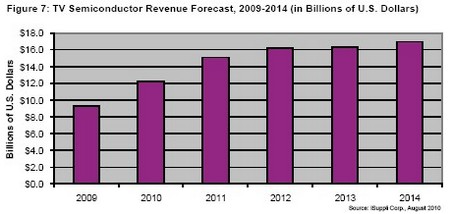
According to iSuppli Corporation, LED backlighting and other advanced TV architectures are entering more and more LCD TVs, which will make 2010 the best performance ever in the global TV semiconductor market.
In 2009, TV semiconductor sales reached US$9.3 billion. As LCD TVs require more semiconductor chips to support various advanced functions, sales in 2010 are expected to increase to higher levels. iSuppli's forecast shows that in 2010 the television semiconductor market will reach $12.1 billion.
This will be the first time it has exceeded the $10 billion mark, which is equivalent to a growth of about 29% in 2010 sales - almost six times the 2009 growth rate of 5.5%.
The graph shows iSuppli's forecast for sales in the global television semiconductor market for 2009-2014, covering all television types of chips, including LCD TVs, plasmas, rear projections, and CRTs.
During the forecast period, LCD TVs will use the highest chip shipments, much higher than all other TV display technologies. This is expected. In contrast, plasma TV chip shipments will remain at 10,000 for the first time, and the downward trend of CRTs will be irreversible. In 2012, the chip shipments of rear-projection TVs will be close to zero.
High-end features - but not 3D, will drive TV semiconductor growth
In the TV semiconductor market, the most lucrative and largest growth area is LED backlighting of LCD TV panels. Compared with the old CCFL technology, LED backlighting provides higher image contrast, lower power consumption, and improved overall product style. With LED backlight, the panel thickness can be made thinner.
Currently, there are more than 150 LCD TVs in the North American market that use LED backlighting, and this number continues to grow. With LED's increasing market share and becoming mainstream, sales of LED-related semiconductors will expand dramatically and will grow from 400 million U.S. dollars in 2009 to more than 4 billion U.S. dollars in 2014. It is estimated that the number of LED-backlit TVs will reach 25 million units in 2010, an increase of over 400% over 2009.
iSuppli's data shows that in addition to LED backlighting, there will be many advanced TV features in the next few years that will drive the growth of the TV semiconductor industry. These features include: Full HD 1080p resolution, Internet access, wireless connectivity, and frame rate conversion for 120/240Hz playback. These features require the use of more advanced video processor chips.
Surprisingly, although 3D technology has become a big hit, it is not expected to be the main growth driver for the TV semiconductor market. However, OEMs and consumers' interest in 3D TV will prompt the 240Hz frame rate to penetrate more quickly in the LCD TV field because of the image crosstalk problem in current 3D solutions. And iSuppli believes that current plans for LCD TV manufacturers and panel suppliers to adopt higher frame rates such as 120Hz and 240Hz will be included in the overall bill of materials and new features required for 3D technology.
Therefore, although 3D predicts that consumers will acquire a new era of advanced TV viewing experience, the technology itself will not significantly affect television semiconductor sales, especially for video processor sales.
LED also stimulates sales growth of power ICs
iSuppli's analysis shows that using LED chips as the backlight for LCD TV panels is also a major factor in the growth of the drive power ICs.
Consumers are increasingly concerned about TV energy consumption. Manufacturers are overcoming this challenge by designing smarter power supplies, audio-video motherboards, and electronics to increase power efficiency and meet more stringent power consumption guidelines set by government regulators. These need to use power ICs.
iSuppli's data shows that in 2010 power IC sales are expected to reach 1.8 billion US dollars, up 38.5% from last year's 1.3 billion US dollars. The growth momentum will remain at least until 2012, when sales will reach 2.5 billion US dollars.
iSuppli's forecast shows that sales are expected to drop to US$2.4 billion in 2013, after which sales will rise again and increase to US$2.7 billion in 2014.
Yifa Stud Welding Equipment Co., Ltd. , http://www.yfweldingmachine.com